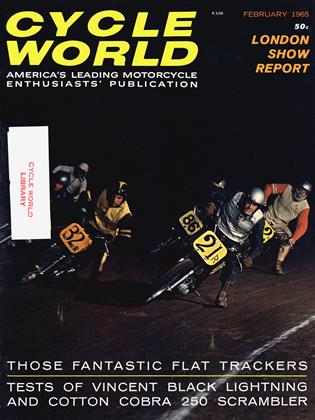JAWA SENSATIONS
SLONIGER
JAWA is BACK in the news in no uncertain way with a sporting and a touring machine, further proof that competition within Czechoslovakia (with CZ) is doing no harm at all to their 1965 program. On the one hand a fresh moto-cross bike, similar to their recent Six Days Trial machinery, is being offered with options to turn it into a restricted-license road racer for the beginner. On the other hand, they have come out with 250/350cc automatics for the open road.
Taking the sports bike first, Jawa is aiming for the European moto-cross championship, 250 division, which fell to rival CZ this past season with Joel Robert riding. To get back in the front row, Jawa and their design boss Jan Krivka (also ISDT manager) have produced a 27 hp single weighing 220 pounds and fitted with five speeds.
A prime feature of the engine is its one-piece bottom end casting on the open principle so that you can remove crankshaft and gearbox without taking the cases from the frame. It eliminates the bother of two halves to match up in the workshop, too. The crank is held by one each roller and ball bearing on the righthand side. The left end rides in a needle bearing in the crankcase lid. Once this lid has been unscrewed the crank unit can be slid out.
The forged con rod has a needle bearing big end with a bronze bushing for the wrist pin. They now use a two-ring cast piston but are toying with forged pistons. The 32mm Czech carburetor rides on a short stub behind the engine, battery ignition is 6-volt but there is provision for mounting a flywheel magneto on the left side if desired.
The five-speed, constant-mesh gearbox uses plain bearings as well, with the shift pedal on the left. By removing the gearbox sprocket you can disembowel the box to the right. The dry-plate clutch is mounted on the right-hand crank pin and the kick starter is also on that side. Both cylinder and head are light metal with a cast iron sleeve for the cylinder. The two plugs in the head fire together.
To carry this husky single, Jawa uses a double-tube frame of square-section tubing, with the rear portion rendered in round tubes. Wheelbase is 51.2 inches. Both fenders are aluminum for lighter weight; the saddle and number plate are fiberglass. The hydraulic front fork is adjustable, and braking comes from 6.3inch drums, though they admit to discbrake experiments. Tires are 2.75 x 21 in front, 4.00 x 18 in back.
On the touring scene, Jawa just introduced their patented centrifugal automatic clutch for the 250cc and 350cc bikes, the first such units in their class. They are available on the regular new Jawas with their improved brakes and front fork and the factory quotes no difference in top speeds: 68 mph for the 15 hp 250 bike and 75 mph for the 18 hp 350. The JawaAutomatic, as they style it, is a multi-disc unit running in oil and fitted to the left end of the gearbox main shaft where it runs at less than crankshaft speed.
Simplified: the unit consists of the
input side, which is a drum integral with the chain wheel. This carries three bob weights interconnected by coil springs. This drum rotates with the gearbox shaft and the weights are forced outward to contact the pressure plate, forcing it to compress the set of clutch plates held at their opposite end by the clutch main springs. There is a free-wheel device to give engine braking on overrun. There are three ways to compress or release the clutch plates. This can happen automatically, based on engine speed; through the free-wheel set; or through the use of the clutch lever on the handlebar, controlled in conjunction with the shift lever.
From idle, feeding throttle picks up the drive progressively and, they say, smoothly; an override disengages the clutch immediately when the throttle is closed. In fact, you can move from rest in any gear but due to heat build-up they don’t recommend it in third or fourth. Alternatively, there is manual override should you want to drop the clutch at high revs for special conditions. Moving the usual foot gear lever automatically disengages the clutch as well, though again you can ride the bike in the old fashioned way, using the hand clutch lever. G












